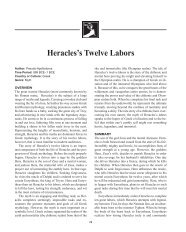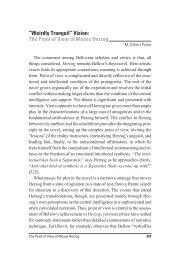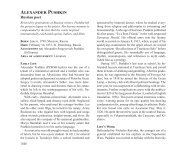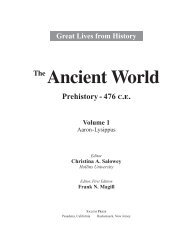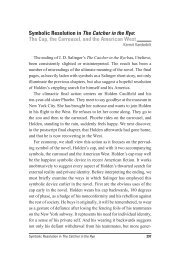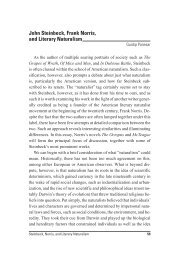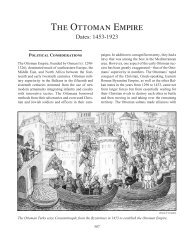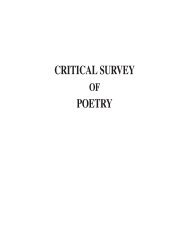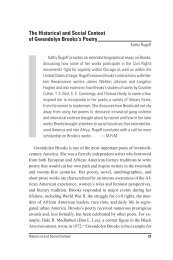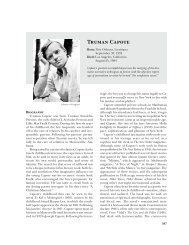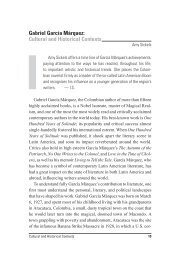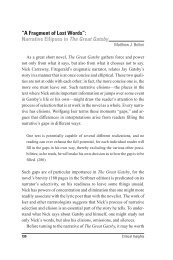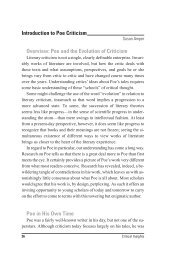Modernity and Anxiety in Bram Stoker's Dracula - Salem Press
Modernity and Anxiety in Bram Stoker's Dracula - Salem Press
Modernity and Anxiety in Bram Stoker's Dracula - Salem Press
Create successful ePaper yourself
Turn your PDF publications into a flip-book with our unique Google optimized e-Paper software.
plete conversion to vampirism—as well as the emphasis placed on the<br />
loss of opportunities for mascul<strong>in</strong>e adventure—the American adventurer<br />
Qu<strong>in</strong>cey Morris serves to show how sheltered <strong>and</strong> protected the<br />
lives of Jonathan Harker <strong>and</strong> the Hon. Arthur Holmwood have become—but<br />
perhaps the most important aspect of the imperial gothic<br />
with<strong>in</strong> the novel is the text’s emphasis on social, geographical, <strong>and</strong> personal<br />
<strong>in</strong>vasion. The strong academic <strong>in</strong>terest <strong>in</strong> postcolonial literary<br />
criticism has made both the reverse colonization anxiety present <strong>in</strong> the<br />
novel as well as the work’s position <strong>in</strong> the imperial gothic subgenre<br />
prime topics of critical conversation <strong>and</strong> debate.<br />
Where, then, we might wonder, is critical analysis of <strong>Dracula</strong><br />
headed <strong>in</strong> the future? There is grow<strong>in</strong>g academic <strong>in</strong>terest <strong>in</strong> the representation<br />
of <strong>in</strong>terior architectural space <strong>in</strong> modern British fiction, <strong>and</strong><br />
as critics cont<strong>in</strong>ue to demonstrate the dramatic role of architecture <strong>in</strong><br />
literature from this period, we are encouraged to reexam<strong>in</strong>e Stoker’s<br />
representation of space. <strong>Dracula</strong> is a novel deeply concerned with<br />
houses <strong>and</strong>, more specifically, the way <strong>in</strong> which characters use architectural<br />
space to dom<strong>in</strong>ate (<strong>in</strong> the case of <strong>Dracula</strong> <strong>and</strong> the un-dead<br />
Lucy) or to liberate (<strong>in</strong> the case of the Crew of Light); the acquisition of<br />
property is the means by which <strong>Dracula</strong> is able to enter <strong>in</strong>to London society,<br />
<strong>and</strong> much of the challenge presented to the Crew of Light is the<br />
locat<strong>in</strong>g of the homes that <strong>Dracula</strong> has purchased throughout metropolitan<br />
<strong>and</strong> suburban London. Although the motif of architectural<br />
space <strong>in</strong> <strong>Dracula</strong> is perhaps not as pronounced as the motif of mass<br />
culture or anxiety about reverse colonization, the ways <strong>in</strong> which Stoker<br />
uses domestic architecture throughout the novel to provide further<br />
comment on <strong>Dracula</strong>’s <strong>in</strong>vasion of London is actually <strong>in</strong>dicative of a<br />
deeply modernist underst<strong>and</strong><strong>in</strong>g of architectural space as a central<br />
component of identity. While a case could be made that Horace Walpole’s<br />
The Castle of Otranto (1764) is one of the earliest literary representations<br />
of <strong>in</strong>terior architectural space, Warren Hunt<strong>in</strong>g Smith argued<br />
<strong>in</strong> his analysis Architecture <strong>in</strong> English Fiction (1934) that the<br />
widespread literary representation of <strong>in</strong>terior architectural space first<br />
<strong>Modernity</strong> <strong>and</strong> <strong>Anxiety</strong> 79



